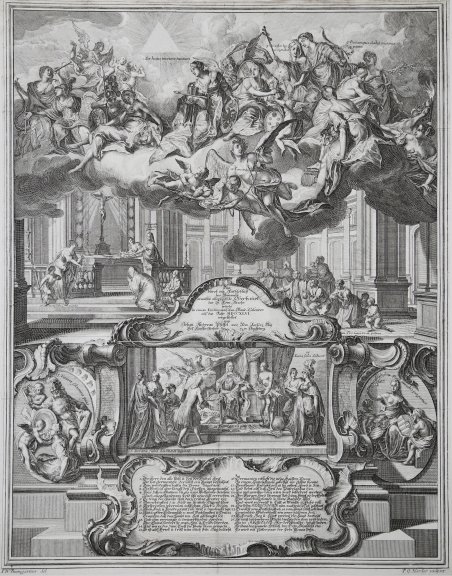Nel cartiglio al centro, il titolo: “Das dürch den Rathschlütss des Himmels erwählte allerhochste Oberhaüpt ' ' des in Röm Reichs mürde in einem Emblematischen Wand-Calender auf das Jahr MDCCXLVI vorgestellet von Johan Andreas Pfeffel… ”. Acquaforte, 1746, firmata nel margine inferiore “I. W. Baumgartner del” e “P. G. Harder sculpsit”, edita da Johan Andreas Pfeffel ad Augsburg. Da un disegno di Johann Wolfgang Baumgartner, inciso da Philipp Gottfried Harder. La grande incisione è una rappresentazione allegorica dell’investitura dell’imperatore del Sacro Romano Impero da parte del Consiglio Celeste. 26 didascalie in latino nel disegno spiegano le immagini. Un esemplare di questa incisione si trovava nella collezione Drugulin (4438) (cfr. Drugulin’s Historical Atlas (1867), p. 380). Johann Wolfgang Baumgartner ' ' (1702 – 1761) è uno dei più importanti e riconosciuti pittori della scuola rococò di Augusta. Oltre ai dipinti di grande formato per gli altari e gli affreschi dei soffitti delle chiese, creò una serie di schizzi, bozzetti e modelli, molti dei quali furono pubblicati in incisioni. Predominano i motivi tratti dalle leggende dei santi. Numerose opere di sua mano si trovano in collezioni private e pubbliche. Johan Andreas Pfeffel (1674 -1748), fu incisore ed editore d'arte. Pfeffel nasce nel 1674 a Bischoffingen. Frequenta l'Accademia Imperiale di Belle Arti di Vienna dove apprende l'uso del cesello e della raschiatura. Nel 1711 si stabilisce ad Augusta dove apre un negozio d'arte con Christian Engelbrecht, che ebbe un grande successo. Produsse numerose opere, anche di grandi dimensioni, fra cui ritratti di personaggi contemporanei, politici, scene teatrali, vedute di luoghi famosi, grandi disegni sugli ordini religiosi, raccolte di immagini di santi ad uso devozionale del popolo, libri d'arte, ornamenti di vario genere. La famosa bibbia Physica Sacra diJohann Jakob Scheuchzer apparve nel 1731-1735 con la sua casa editrice. Quanto al lavoro di incisione si appoggiò anche ad altri artisti come Johann Evangelist Holzer. Anche suo figlio (1715-1768) divenne un incisore di rame. Johann Andreas Pfeffel morì ad Augusta nel 1748. Magnifica prova, impressa su due fogli di carta vergata coeva, rifilata al rame o con sottili margini, in ottimo stato di conservazione. Rarissima. In the central cartouche, the title: ' “Das dürch den Rathschlütss des Himmels erwählte allerhochste Oberhaüpt ' des in Röm Reichs mürde in einem Emblematischen Wand-Calender auf das Jahr MDCCXLVI vorgestellet von Johan Andreas Pfeffel… ”. Emblematic calendar for the year 1746 published by Johann Andrea Pfeffel - engraver, painter and publisher from Augsburg (1674 - 1748), engraved by Philipp Gottfried Harder (1710 - 1749) ' after a drawing a by Johann Wolfgang Baumgartner. The large engraving is an allegorical depiction of the investiture of the Holy Roman Emperor by the Celestial Council. 26 Latin captions in the drawing explain the images. Etching, 1746, signed in the lower margin "I. W. Baumgartner del" and "P. G. Harder sculpsit" An example of this etching was in the Drugulin collection (4438) (see ' Drugulin's Historical Atlas ' (1867), p. 380. Johann Wolfgang Baumgartner ' (1702 – 1761) ' is one of the most important and recognized painters of the Augsburg Rococo school. In addition to large-scale paintings for altars and frescoes on church ceilings, he created a series of sketches, sketches and models, many of which were published in engravings. Motifs from the legends of the saints predominate. Numerous works by his hand are found in private and public collections. Johan Andreas Pfeffel (1674 -1748), An engraver and art publisher, Pfeffel was born in 1674 in Bischoffingen. He attended the Imperial Academy of Fine Arts in Vienna where he learned the use of chiseling and scraping. In 1711 he settled in Augsburg where he opened an art store with Christian Engelbrecht, which was very successful. He produced numerous works, including large-scale portraits of contemporary figures, politicians, theatrical scenes, views of famous places, large drawings on religious orders, collections of images of saints for the devotional use of the people, art books, and ornaments of various kinds. The famous Physica Sacra Bible byJohann Jakob Scheuchzer appeared in 1731-1735 with his publishing house. As for engraving work he also relied on other artists such as Johann Evangelist Holzer. His son (1715-1768) also became a copperplate engraver. Johann Andreas Pfeffel died in Augsburg in 1748. Magnificent proof, printed on two sheets of contemporary paper, trimmed to copperplate or thin margins, in excellent condition. Very rare. Cfr.

Scopri come utilizzare
Scopri come utilizzare

